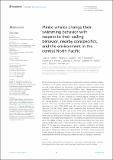Files in this item
Minke whales change their swimming behavior with respect to their calling behavior, nearby conspecifics, and the environment in the central North Pacific
Item metadata
| dc.contributor.author | Helble, T.A. | |
| dc.contributor.author | Guazzo, R.A. | |
| dc.contributor.author | Durbach, I.N. | |
| dc.contributor.author | Martin, C.R. | |
| dc.contributor.author | Alongi, G.C. | |
| dc.contributor.author | Martin, S.W. | |
| dc.contributor.author | Henderson, E.E. | |
| dc.date.accessioned | 2023-05-03T11:30:03Z | |
| dc.date.available | 2023-05-03T11:30:03Z | |
| dc.date.issued | 2023-04-11 | |
| dc.identifier | 285328858 | |
| dc.identifier | 469430a6-36ec-40ab-bafe-c8b8820de05c | |
| dc.identifier | 85153520411 | |
| dc.identifier.citation | Helble , T A , Guazzo , R A , Durbach , I N , Martin , C R , Alongi , G C , Martin , S W & Henderson , E E 2023 , ' Minke whales change their swimming behavior with respect to their calling behavior, nearby conspecifics, and the environment in the central North Pacific ' , Frontiers in Marine Science , vol. 10 , 1148987 . https://doi.org/10.3389/fmars.2023.1148987 | en |
| dc.identifier.issn | 2296-7745 | |
| dc.identifier.other | RIS: urn:2AD1E1F11B243A059032352F312B6C6E | |
| dc.identifier.other | ORCID: /0000-0003-0769-2153/work/134491471 | |
| dc.identifier.uri | https://hdl.handle.net/10023/27498 | |
| dc.description | Funding: This research was supported by the Office of Naval Research (Code 322, Award Number N0001422WX01263), Commander, U.S. Pacific Fleet (Code N465JR, Award Number N0007023WR0EP8F), and tool development necessary for this analysis was supported by the U.S. Navy’s Living Marine Resources Program (Award Number N0002520WR0141R). | en |
| dc.description.abstract | Behavioral responses to sonar have been observed in a number of baleen whales, including minke whales (Balaenoptera acutorostrata). Previous studies used acoustic minke whale boing detections to localize and track individual whales on the U.S. Pacific Missile Range Facility (PMRF) in Kaua ‘i, Hawai‘i before, during, and after Navy training activities. These analyses showed significant changes in central North Pacific minke whale distribution and swimming behavior during Navy sonar events. For the purposes of contextualizing changes in animal movement relative to Navy sonar, we expanded on this research to examine the natural variation in minke whale movement when Navy sonar was not present. This study included 2,245 acoustically derived minke whale tracks spanning the years 2012–2017 over all months that minke whales were detected (October–May). Minke whale movement was examined relative to calling season, day of the year, hour of day, wind speed, calling state (nominal or rapid), and distance to the nearest calling conspecific. Hidden Markov models were used to identify two kinematic states (slower, less directional movement and faster, more directional movement). The findings indicate that minke whales were more likely to travel in a faster and more directional state when they were calling rapidly, when other vocalizing minke whales were nearby, during certain times of the day and calling seasons, and in windier conditions, but these changes in movement were less intense than the changes observed during exposure to Navy sonar, when swim speeds were the fastest. These results start to put behavioral responses to Navy sonar into an environmental context to understand the severity of responses relative to natural changes in behavior. | |
| dc.format.extent | 12 | |
| dc.format.extent | 2321037 | |
| dc.language.iso | eng | |
| dc.relation.ispartof | Frontiers in Marine Science | en |
| dc.subject | Behavior | en |
| dc.subject | Boing vocalization | en |
| dc.subject | Kinematics | en |
| dc.subject | Marine ecology | en |
| dc.subject | Minke whale (Balaenoptera acutorostrata) | en |
| dc.subject | Navy sonar | en |
| dc.subject | Passive acoustic monitoring | en |
| dc.subject | Swimming speed | en |
| dc.subject | QL Zoology | en |
| dc.subject | DAS | en |
| dc.subject | SDG 14 - Life Below Water | en |
| dc.subject | MCC | en |
| dc.subject.lcc | QL | en |
| dc.title | Minke whales change their swimming behavior with respect to their calling behavior, nearby conspecifics, and the environment in the central North Pacific | en |
| dc.type | Journal article | en |
| dc.contributor.institution | University of St Andrews. School of Mathematics and Statistics | en |
| dc.contributor.institution | University of St Andrews. Centre for Research into Ecological & Environmental Modelling | en |
| dc.identifier.doi | https://doi.org/10.3389/fmars.2023.1148987 | |
| dc.description.status | Peer reviewed | en |
This item appears in the following Collection(s)
Items in the St Andrews Research Repository are protected by copyright, with all rights reserved, unless otherwise indicated.

